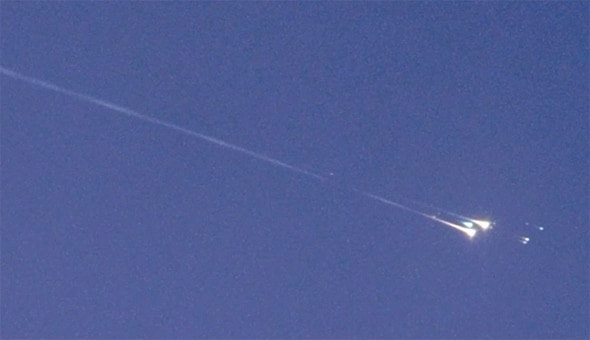Create a free profile to get unlimited access to exclusive videos, sweepstakes, and more!
Update: Whatever WT1190F Was, It Isn’t Any More

This morning, just before 06:20 UTC and right on schedule, a small bit of space junk called WT1190F slammed into Earth’s atmosphere at nearly 40,000 kilometers per hour. The huge pressure generated as it plowed through the air heated it up, broke it to pieces, and it disintegrated.
We’re still not sure what it was, other than it was likely a piece of hardware from an earlier mission to the Moon. But we know for a fact it burned up: We have pictures!
The photo at the top was taken by a joint aircraft mission sponsored by the International Astronomical Center and the United Arab Emirates Space Agency. They were flying over the thick clouds covering the Sri Lanka coast and were able to get some pretty amazing shots of WT1190F as it came in. Here’s a brief video featuring a short animation and some of the photos:
Coooooool. That pretty much removes any doubt it was some human-made object; such things tend to break up and fall as parallel clusters of fireballs (for example, the Cosmos 1315 satellite, the Janice Voss ISS resupply ship, the Albert Einstein, and many others). That can happen with asteroids and other natural detritus, but not often, and it usually doesn’t look quite like this.
The weather prevented anyone from the ground seeing the event, but there are some reports of a loud noise around the same time. Of course, that could be thunder—like I said, the clouds were thick—but it’s possible it was the sonic boom from the debris as it passed through the air at hypersonic speed. I wonder if we’ll ever know …?
Sometimes, you have to be satisfied with not knowing. We may never find out exactly what mission this hardware was from. Science is like that. For every question we answer a hundred more pop up, and sometimes you just never know. The important part in this case is that the object was seen, it was identified in previous observations from years before, and that allowed an accurate orbit to be determined and a time of entry calculated.
Think about that! It was only rediscovered on Oct. 3, yet astronomers were able to pinpoint almost exactly when and where this thing would come down.
That’s astonishing. But then, that’s science.
Tip o’ the Whipple Shield to Jonathan McDowell.
More about WT1190F from shortly after it was discovered:
Correction, Nov. 13, 2015: I originally incorrectly identified the debris as WT1109F.


























